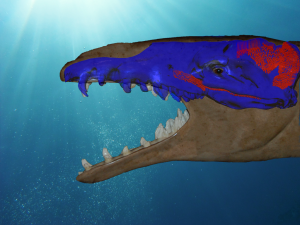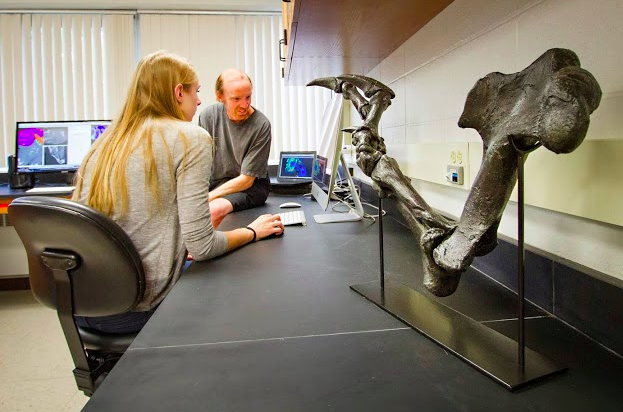Posted 2:23 p.m. Wednesday, Feb. 25, 2015

UW-L assistant professor's project on bite force gives students researchers experience in engineering and computer science.
Students researchers gain skills in engineering, computer science
[caption id="attachment_39289" align="alignright" width="300"] A Basilosaurus isis skull. The red represents muscle forces, and the blue color of the cranium shows that the skull has very low stress. The original life reconstruction in this image, by artist John Klausmeyer, is at the Museum of Paleontology, University of Michigan.[/caption]
It has the biggest bite force estimated for any mammal — ever.
Its jaws could crush bones with enough force to lift a Ford F150 extended cab.
Good thing it’s extinct.
But Eric Snively, a paleontologist and UW-L assistant professor, is alive and well to tell all about the ancient whale, Basilosaurus isis, and its incredible ability to bite. His research on the bite force of the mammal that swam the world’s oceans 34-40 million years ago was published in the scientific journal PLOS ONE on Wednesday, Feb. 25.
Snively wrote the paper with co-authors Julia Fahlke, a postdoctoral fellow at the Museum of Natural History in Berlin, Germany and Robert Welsh, University of Michigan, whose scientists excavated and now curate the skull.
While the research gives scientists more clues about evolution of whales, it also gives UW-L student researchers practice for careers in medical and engineering fields.
Snively and his students analyze bite force using CT scans, virtual engineering models of the ancient whale skull and careful consideration of the animal’s anatomy. The high tech computer software used in the lab is similar to what students will use in future careers. UW-L freshmen Ryan Sokup wants to one day be an orthopedic surgeon.
“Analyzing forces and stresses on bones and how they impact organisms is interesting to me and goes hand-in-hand with my future career plans,” he says.
Sokup and Erin Wick are research assistants through UW-L’s Eagle Apprenticeship program, which pairs freshmen with faculty mentors who provide them research or other assistantship experience. Sokup calls it “a unique chance to participate in meaningful research as an underclassmen.” Such hands-on research and mentoring experience early in college is uncommon at many universities.
Wick is using the hands-on science to gauge her interest in different areas of the health sciences. “It is very interesting to work with these computer programs as the work done will help my computer knowledge if I pursue my interest in echocardiography,” she adds.
[caption id="attachment_39294" align="alignright" width="623"]
A Basilosaurus isis skull. The red represents muscle forces, and the blue color of the cranium shows that the skull has very low stress. The original life reconstruction in this image, by artist John Klausmeyer, is at the Museum of Paleontology, University of Michigan.[/caption]
It has the biggest bite force estimated for any mammal — ever.
Its jaws could crush bones with enough force to lift a Ford F150 extended cab.
Good thing it’s extinct.
But Eric Snively, a paleontologist and UW-L assistant professor, is alive and well to tell all about the ancient whale, Basilosaurus isis, and its incredible ability to bite. His research on the bite force of the mammal that swam the world’s oceans 34-40 million years ago was published in the scientific journal PLOS ONE on Wednesday, Feb. 25.
Snively wrote the paper with co-authors Julia Fahlke, a postdoctoral fellow at the Museum of Natural History in Berlin, Germany and Robert Welsh, University of Michigan, whose scientists excavated and now curate the skull.
While the research gives scientists more clues about evolution of whales, it also gives UW-L student researchers practice for careers in medical and engineering fields.
Snively and his students analyze bite force using CT scans, virtual engineering models of the ancient whale skull and careful consideration of the animal’s anatomy. The high tech computer software used in the lab is similar to what students will use in future careers. UW-L freshmen Ryan Sokup wants to one day be an orthopedic surgeon.
“Analyzing forces and stresses on bones and how they impact organisms is interesting to me and goes hand-in-hand with my future career plans,” he says.
Sokup and Erin Wick are research assistants through UW-L’s Eagle Apprenticeship program, which pairs freshmen with faculty mentors who provide them research or other assistantship experience. Sokup calls it “a unique chance to participate in meaningful research as an underclassmen.” Such hands-on research and mentoring experience early in college is uncommon at many universities.
Wick is using the hands-on science to gauge her interest in different areas of the health sciences. “It is very interesting to work with these computer programs as the work done will help my computer knowledge if I pursue my interest in echocardiography,” she adds.
[caption id="attachment_39294" align="alignright" width="623"] Assistant Professor Eric Snively in his lab where students assist him with various projects related to dinosaurs and other extinct animals.[/caption]
While students are excited about how the project prepares them for their future, they also share their professor’s enthusiasm for the past.
“I mean, who doesn't think dinosaurs are awesome?,” says Cody Fisher, a UW-L student who works on a separate project in Snively’s lab.
Although not a dinosaur, Basilosaurus is justifiable in anyone’s top 10 of extinct animals, adds Snively. An analysis of its bite force shows how whales succeeded at early stages adapting to water using their ability to bite. These ancient whales captured prey in their front teeth, and then crushed and sliced through bones. This set the stage for later evolution of predatory whales — including today’s killer and sperm whales.
Hippos are likely to have the highest absolute bite force of any modern land mammal.
The paper is called “Bone-Breaking Bite Force of Basilosaurus isis (Mammalia, Cetacea) from the Late Eocene of Egypt Estimated by Finite Element Analysis.”
Assistant Professor Eric Snively in his lab where students assist him with various projects related to dinosaurs and other extinct animals.[/caption]
While students are excited about how the project prepares them for their future, they also share their professor’s enthusiasm for the past.
“I mean, who doesn't think dinosaurs are awesome?,” says Cody Fisher, a UW-L student who works on a separate project in Snively’s lab.
Although not a dinosaur, Basilosaurus is justifiable in anyone’s top 10 of extinct animals, adds Snively. An analysis of its bite force shows how whales succeeded at early stages adapting to water using their ability to bite. These ancient whales captured prey in their front teeth, and then crushed and sliced through bones. This set the stage for later evolution of predatory whales — including today’s killer and sperm whales.
Hippos are likely to have the highest absolute bite force of any modern land mammal.
The paper is called “Bone-Breaking Bite Force of Basilosaurus isis (Mammalia, Cetacea) from the Late Eocene of Egypt Estimated by Finite Element Analysis.”
